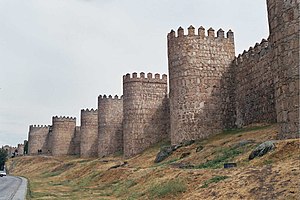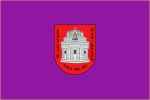Ávila: Difference between revisions
new pictures added |
new pictures added |
||
| Line 110: | Line 110: | ||
Ávila may have been the ancient town known as ''Abula'', mentioned by [[Ptolemy]] in his ''Geographia'' (II 6, 60) as being located in the Iberian region of [[Bastetania]].<ref name="abulenses"> {{cite web|url=http://centrodeestudiosabulenses.blogia.com/temas/abulenses.php|author=Avitiano|title= Abulenses |publisher=Centro de estudios abulenses|date= December 23, 2008|accessdate=February 20|accessyear=2009}} </ref> Abula is mentioned as one of the first cities in [[Hispania]] that was [[Christianity|Christianized]], specifically by [[Secundus of Abula|Saint Secundus]] (''San Segundo'').<ref name="abulenses"/> However, Ávila may have been the ancient ''Obila'' instead, while ''Abula'' may have been the town of [[Abla]].<ref name="abulenses"/> |
Ávila may have been the ancient town known as ''Abula'', mentioned by [[Ptolemy]] in his ''Geographia'' (II 6, 60) as being located in the Iberian region of [[Bastetania]].<ref name="abulenses"> {{cite web|url=http://centrodeestudiosabulenses.blogia.com/temas/abulenses.php|author=Avitiano|title= Abulenses |publisher=Centro de estudios abulenses|date= December 23, 2008|accessdate=February 20|accessyear=2009}} </ref> Abula is mentioned as one of the first cities in [[Hispania]] that was [[Christianity|Christianized]], specifically by [[Secundus of Abula|Saint Secundus]] (''San Segundo'').<ref name="abulenses"/> However, Ávila may have been the ancient ''Obila'' instead, while ''Abula'' may have been the town of [[Abla]].<ref name="abulenses"/> |
||
Ávila is most known for the medieval [[city walls]]<ref>[http://www.travelinginspain.com/Avila.htm Avila] World Heritage Sites in Spain at travelinginspain.com.</ref>, that were constructed of brown [[granite]] in 1090: surmounted by a [[Breastwork (fortification)|breastwork]], with eighty-eight [[tower]]s and nine [[gate]]ways, they are still in excellent repair, but a large part of the city lies beyond their perimeter. The [[Cathedral of Ávila|Gothic cathedral]] is integrated into the city's defences. It was built between the 12th and 14th centuries, and has the appearance of a fortress, with [[crenellation|embattled]] walls and two solid towers. It contains many interesting sculptures and paintings, besides one especially fine silver [[pyx]], the work of [[Juan de Arphe y Villafañe|Juán de Arfe]], dating from 1571. [[Image:Avila Torreon de los Gusmanes.jpg| |
Ávila is most known for the medieval [[city walls]]<ref>[http://www.travelinginspain.com/Avila.htm Avila] World Heritage Sites in Spain at travelinginspain.com.</ref>, that were constructed of brown [[granite]] in 1090: surmounted by a [[Breastwork (fortification)|breastwork]], with eighty-eight [[tower]]s and nine [[gate]]ways, they are still in excellent repair, but a large part of the city lies beyond their perimeter. The [[Cathedral of Ávila|Gothic cathedral]] is integrated into the city's defences. It was built between the 12th and 14th centuries, and has the appearance of a fortress, with [[crenellation|embattled]] walls and two solid towers. It contains many interesting sculptures and paintings, besides one especially fine silver [[pyx]], the work of [[Juan de Arphe y Villafañe|Juán de Arfe]], dating from 1571. [[Image:Avila Torreon de los Gusmanes.jpg|165px|thumb|Torreón de los Guzmanes.]] |
||
[[Image:Ávila Chatedral main view.jpg|thumb|150px|left|Ávila Cathedral]] |
[[Image:Ávila Chatedral main view.jpg|thumb|150px|left|Ávila Cathedral]] |
||
The churches of San Vicente, San Pedro and San Segundo are, in their main features, [[Romanesque architecture|Romanesque]] of the 12th century. |
The churches of San Vicente, San Pedro and San Segundo are, in their main features, [[Romanesque architecture|Romanesque]] of the 12th century. |
||
| Line 124: | Line 124: | ||
<gallery> |
<gallery> |
||
Image:Murallas de Ávila.jpg|Complete view of the Walls of Ávila. |
|||
Image:Ávila. Murallas 2.JPG|Other view of a part of the walls. |
|||
Image:Avila_Spain_345.JPG|Northwest side of the Walls of Ávila. |
|||
Image:Avila nevada.JPG|Ávila on winter (2005 february) |
|||
Image:Ávila. Catedral 1.JPG|Ávila Cathedral as seen from Tomás Luis de Victoria street. |
Image:Ávila. Catedral 1.JPG|Ávila Cathedral as seen from Tomás Luis de Victoria street. |
||
Image:Catedral de Ávila, portada norte, detalle.JPG|View of northern facade of the Ávila Cathedral. |
Image:Catedral de Ávila, portada norte, detalle.JPG|View of northern facade of the Ávila Cathedral. |
||
| Line 137: | Line 141: | ||
Image:El Real Monasterio de Santo Tomas-1.jpg|Real Monasterio de Santo Tomas. |
Image:El Real Monasterio de Santo Tomas-1.jpg|Real Monasterio de Santo Tomas. |
||
Image:Ermitadesonsoles.jpg|Sanctuary of Nuestra Señora de Sonsoles. |
Image:Ermitadesonsoles.jpg|Sanctuary of Nuestra Señora de Sonsoles. |
||
Image:Cuatro postes avila.jpg|Roman monument know as «Los Cuatro Postes» |
|||
Image:restos romanos avila.jpg|Roman ruines. |
|||
Image:CILII3865.JPG|Inscription dedicated to ''G. Antonius daugeti filius'' in the wall of the city. |
|||
Image:Ávila. Plaza del Mercado Chico.JPG|Plaza del Mercado Chico, a [[Middle Ages|medieval market]]. |
Image:Ávila. Plaza del Mercado Chico.JPG|Plaza del Mercado Chico, a [[Middle Ages|medieval market]]. |
||
Image:Universidadcatolica-.jpg|Principal building of Catholic University of Ávila. |
Image:Universidadcatolica-.jpg|Principal building of Catholic University of Ávila. |
||
Revision as of 00:29, 15 August 2009
Ávila
Ávila de los Caballeros, Ávila del Rey, Ávila de los leales | |
|---|---|
Ávila with its famous city walls, as seen from a distance | |
| Motto(s): | |
| Location Location | |
| Country | Spain |
| Autonomous Community | Castilla y León |
| Province | Ávila |
| Government | |
| • Mayor | Miguel Ángel García Nieto (PP) |
| Area | |
| • Land | 231.9 km2 (89.5 sq mi) |
| Elevation | 1,182 m (3,665 ft) |
| Population (2005) | |
| • Total | 53,272 |
| • Density | 226.87/km2 (587.6/sq mi) |
| Time zone | UTC+1 (CET) |
| • Summer (DST) | UTC+2 (CEST) |
| Postal code | 05001 - 05005 |
| Area code | 34 (Spain) + 92 (Ávila) |
| Website | http://www.avila.es Template:Es icon |
| UNESCO World Heritage Site | |
|---|---|
 | |
| Criteria | Cultural: iii, iv |
| Reference | 348 |
| Inscription | 1985 (9th Session) |
Ávila de los Caballeros (Latin: Abila and Óbila) is the capital of the province of the same name, now part of the autonomous community of Castile and León, Spain.
Geography
The city is 1117 meters (3665 feet) above sea level, the highest provincial capital in Spain. It is built on the flat summit of a rocky hill, which rises abruptly in the midst of a veritable wilderness: a brown, arid, treeless table-land, strewn with immense grey boulders, and shut in by lofty mountains. This results in an extreme climate, with very hard and long winters, and short summers.
History

Ávila may have been the ancient town known as Abula, mentioned by Ptolemy in his Geographia (II 6, 60) as being located in the Iberian region of Bastetania.[1] Abula is mentioned as one of the first cities in Hispania that was Christianized, specifically by Saint Secundus (San Segundo).[1] However, Ávila may have been the ancient Obila instead, while Abula may have been the town of Abla.[1]
Ávila is most known for the medieval city walls[2], that were constructed of brown granite in 1090: surmounted by a breastwork, with eighty-eight towers and nine gateways, they are still in excellent repair, but a large part of the city lies beyond their perimeter. The Gothic cathedral is integrated into the city's defences. It was built between the 12th and 14th centuries, and has the appearance of a fortress, with embattled walls and two solid towers. It contains many interesting sculptures and paintings, besides one especially fine silver pyx, the work of Juán de Arfe, dating from 1571.


The churches of San Vicente, San Pedro and San Segundo are, in their main features, Romanesque of the 12th century. In the Gothic Monastery of Santo Tomás, erected by the Catholic Queen Isabella in 1482, is especially noteworthy the marble monument, carved by the 15th-century Florentine sculptor Domenico Fancelli, over the tomb of Prince John, the only son of Ferdinand and Isabella.
Famous residents
Ávila was the birthplace of the 4th-century theologian Priscillian, the first Christian to be executed for heresy. The town is more renowned for St. Teresa of Ávila, the Carmelite reformer who lived there twelve centuries later (c. 1515-1582). A convent and church mark the supposed birthplace of Santa Teresa, but she was born in Gotarrendura in the Ávila province. Other prominent natives include Saint John of the Cross, Tomás Luis de Victoria and the Spanish-born American philosopher George Santayana. From 1482 to 1807 it was also the seat of a university.
Food
Typical food in Ávila includes roast lamb, suckling pig, and veal steak. Ávila is also famous for its yemas de Santa Teresa - egg yolk candies named after the patron saint.
Gallery
-
Complete view of the Walls of Ávila.
-
Other view of a part of the walls.
-
Northwest side of the Walls of Ávila.
-
Ávila on winter (2005 february)
-
Ávila Cathedral as seen from Tomás Luis de Victoria street.
-
View of northern facade of the Ávila Cathedral.
-
Apse of the Ávila Cathedral.
-
Basílica de San Vicente.
-
Basílica de San Vicente.
-
Basílica de San Vicente. western facade.
-
Convento de Santa Teresa.
-
La Plaza de Santa Teresa, both with the Church San Pedro.
-
Santa Teresa´s feast day (2007).
-
Monasterio de Santo Tomás.
-
San Pedro, Ávila
-
Real Monasterio de Santo Tomas.
-
Sanctuary of Nuestra Señora de Sonsoles.
-
Roman monument know as «Los Cuatro Postes»
-
Roman ruines.
-
Inscription dedicated to G. Antonius daugeti filius in the wall of the city.
-
Plaza del Mercado Chico, a medieval market.
-
Principal building of Catholic University of Ávila.
-
Ayuntamiento.
-
Jardín de El Soto.
-
Yemas de Santa Teresa, typical dessert of Ávila.
References
External links
- Avila's City Hall
- Avila's Tourist Guide
- Convent of St. Teresa, Avila
- Photos of Avila
- Satellite picture by Google Maps
- Hazlitt, Classical Gazetteer "Abila"
- Citizens' association for the defence of heritage of Avila - Photos of Avila
40°39′N 4°42′W / 40.650°N 4.700°W
- This article incorporates text from a publication now in the public domain: Chisholm, Hugh, ed. (1911). Encyclopædia Britannica (11th ed.). Cambridge University Press.
{{cite encyclopedia}}: Missing or empty|title=(help)

























